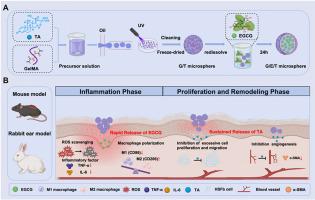Sequential drug-release microsphere system for scarless wound healing
IF 10.2
1区 医学
Q1 ENGINEERING, BIOMEDICAL
引用次数: 0
Abstract
The dynamic imbalance in skin wound healing is a key factor of hypertrophic scar (HS) formation. Traditional treatments often target only a certain stage of the wound healing process and fail to comprehensively address the dynamic imbalance, thus making it difficult to achieve scarless wound healing. This study developed a chronologically adaptive methacrylylated gelatin (GelMA)-based microsphere delivery system (G/E/T) that achieves comprehensive intervention in wound healing process through precisely orchestrated sequential release of epigallocatechin gallate (EGCG) and triamcinolone acetonide (TA). In vitro studies have confirmed that the G/E/T microsphere system, utilizing this sequential release mechanism, not only alleviates oxidative stress and inflammatory responses in the early stages but also persistently inhibits the excessive proliferation and migration of fibroblasts in the later phases, demonstrating stage-specific therapeutic precision. Moreover, validated through mouse full-thickness wound model and rabbit ear HS model, the system exhibited remarkable scarless healing outcomes. The "sequential release and dual-agent synergy" design paradigm provides an innovative strategy for scarless wound healing while establishing a foundational framework for developing sequential multidrug delivery systems targeting complex pathological processes.

序贯释药微球系统用于无疤痕伤口愈合
皮肤创面愈合过程中的动态不平衡是肥厚性瘢痕形成的关键因素。传统的治疗方法往往只针对创面愈合过程的某一阶段,未能全面解决动态不平衡问题,难以实现创面无疤痕愈合。本研究开发了一种基于甲基丙烯酸明胶(GelMA)的时序适应性微球递送系统(G/E/T),该系统通过精确的顺序释放表没食子儿茶素没食子酸酯(EGCG)和曲安奈德(TA)来实现对伤口愈合过程的全面干预。体外研究证实,G/E/T微球系统利用这种顺序释放机制,不仅在早期缓解氧化应激和炎症反应,而且在后期持续抑制成纤维细胞的过度增殖和迁移,显示出阶段性的治疗精度。此外,通过小鼠全层创面模型和兔耳HS模型验证,该系统具有显著的无瘢痕愈合效果。“顺序释放和双药协同”设计范式为无疤痕伤口愈合提供了一种创新策略,同时为开发针对复杂病理过程的顺序多药递送系统建立了基础框架。
本文章由计算机程序翻译,如有差异,请以英文原文为准。
求助全文
约1分钟内获得全文
求助全文
来源期刊

Materials Today Bio
Multiple-
CiteScore
8.30
自引率
4.90%
发文量
303
审稿时长
30 days
期刊介绍:
Materials Today Bio is a multidisciplinary journal that specializes in the intersection between biology and materials science, chemistry, physics, engineering, and medicine. It covers various aspects such as the design and assembly of new structures, their interaction with biological systems, functionalization, bioimaging, therapies, and diagnostics in healthcare. The journal aims to showcase the most significant advancements and discoveries in this field. As part of the Materials Today family, Materials Today Bio provides rigorous peer review, quick decision-making, and high visibility for authors. It is indexed in Scopus, PubMed Central, Emerging Sources, Citation Index (ESCI), and Directory of Open Access Journals (DOAJ).
 求助内容:
求助内容: 应助结果提醒方式:
应助结果提醒方式:


